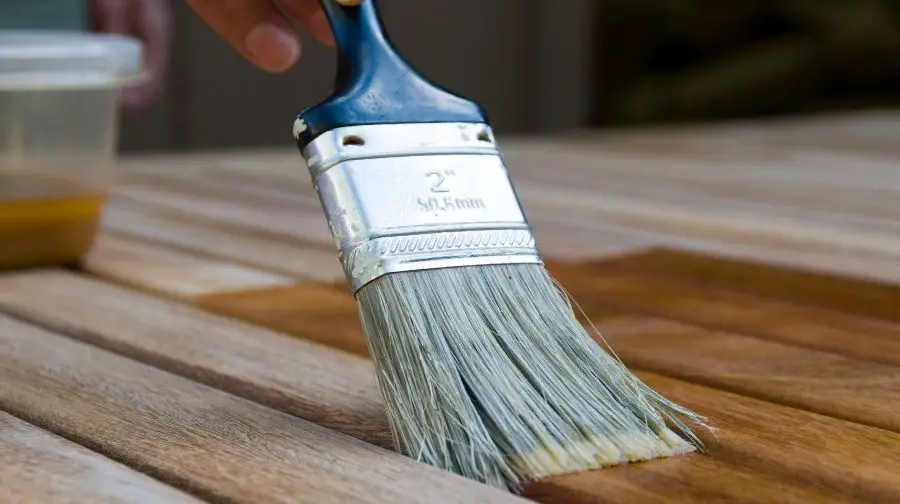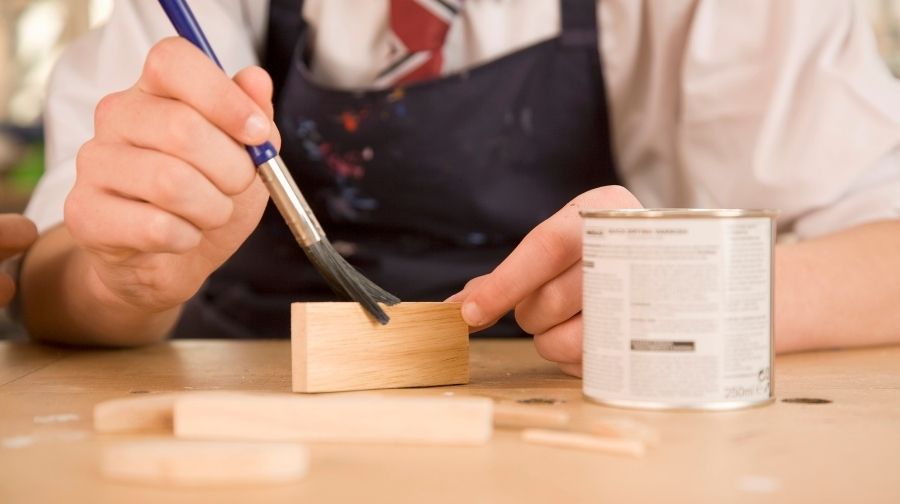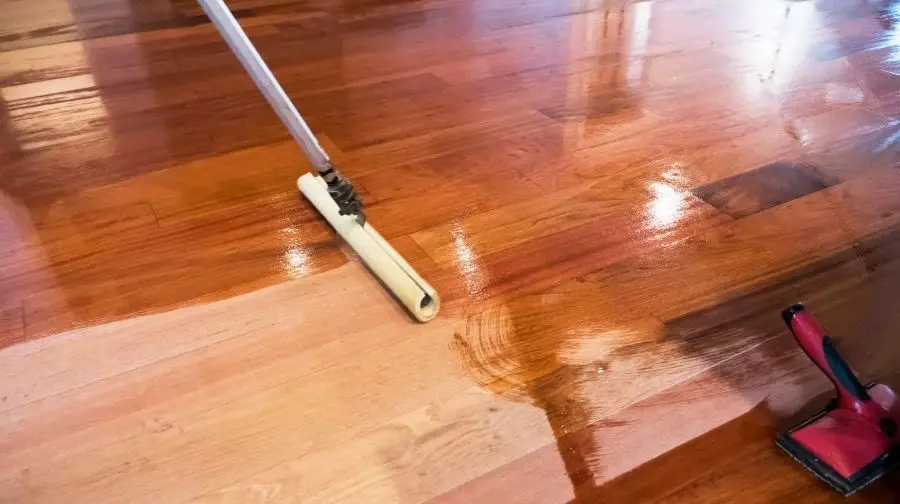
The process of staining enhances the beauty of furniture and gives it a luxurious look. There are various types and colors of staining, and by using the best combination of these, one can pull out the glamour of the art one is performing on a piece.
Wood stain is the type of liquid that is a paint-like substance. If it is applied finely, it penetrates into the body of the wood and binds it. It does not only stay on the top of the wood but also soaks the color into the wood to make it less likely to go away.
How Long Does Wood Stain Take To Dry
Generally, stains take 24-48 hours to dry fully. Sometimes, you may have to wait for 72 hours or more before completing your project because drying times vary according to the brands and products, stain types, and environmental conditions.
Types of Wood Stain
Here are given some prominent types of the wood stain:
- Water-based
- Oil-based
- Varnish
- Lacquer
- Gel-based
- Dye stain
The Factors That Drying Time Depend On
The type of wood stain is a major factor that impacts the dry time. Although, environmental conditions affect the drying time by considering the surface, painting, temperature, humidity, and ventilation.
Type of wood:
The surface of wood determines the drying time as softwoods absorb stains unevenly, which take longer to dry. These woods include pine, maple, spruce, alder, pine, and aspen, for these woods require a wood conditioner to prevent defects in the stain.
Temperature:
Temperature is another decisive factor in the dry time for both paints and stains. The best wood stain temperature is considered between 50 and 90 degrees F, with 70 degrees F as an ideal one. Still, it is best to check the stain label first to fit the stain in the best manner.
Ventilation:
Ventilation or air circulation is also a crucial factor when working with stains. The airflow allows the release of moisture from the paint, which is better for stain locks into place. In addition, Stains will dry faster with added air circulation.
Humidity:
The last but not least factor to consider is humidity when staining wood. Humid days and regions could highly impact the drying process. As the paint’s moisture evaporates, the stain gets dried when the color pigments soak into the wood’s surface. The best practice to complete a project during the time of the day is when humidity is between 50 and 70%. Humidity level could impact the stain’s dry time.
Five Effective Ways to Make Wood Stain Dry Faster
- Using Heater
An easy way to dry the wood stains is to increase the temperature gradually, which will help the liquid chemical to heat up. After that reaches the right temperature, it evaporates, leaving only the solute behind. It will come with an A-grade stain job on the wooden piece in a short time. The faster the isolated room warmed up; the quicker stains will dry. So, if the temperature is high or the room is small, both will faster the drying process. But keep in mind not to overdo the temperature because it will cost you the finished texture of the wooden piece.
- Decreasing the Humidity Level by Air Conditioning
Humidity plays a crucial role in drying wood stains. In the case of lower humidity, the air tends to draw out all the moisture. When the room temperature reaches a low humid state, it will start operating the solvent from the wood stain and dry it out more quickly.
- Creating a Greater Flow of Air
The consistent flow of air on the area where the wood piece is placed can ensure a greater rate of drying wood stain process. Remember, this will only result in constant airflow as the airflow will move the evaporated solvent particle away from the wooden piece and will make room for new drier air to sponge out more solvent. IT can also be achieved by using a fan in the room.
- Ensuring Proper Ventilation
Proper ventilation in a room is inevitable for the proper absorption of all the applied stains. There will be no leftover fumes from the evaporated solvents, and the stains will quickly penetrate and be absorbed. One can simply open a window for ventilation. It will, of course, not dry the wooden piece at a fast speed but sure is more than nothing.
- Placing the Piece Outside
If the outside environment is less humid, warm, and dry, then wood stain usually takes 24-72 hours to dry, which is far better. It is advised not to touch or move the stained surface for at least a day. If the environment is accordingly, it would be a great idea to place the wooden item outside.
Speeding Up The Drying Time-Oil Based Finish
Subscribe to Chris Cute on Youtube
How Long To Let Stain Dry before Wiping Off
Here are some tips to let the stain wipe off to get the exact color shade as follows:
- For a light color shade, apply and wipe the stain immediately.
- For a medium color shade, let the stain dry for 5-10 minutes before wiping off.
- For a dark shade, let the stain dry for 20-30 minutes before wiping off.
The Timespan of Exterior Wood Stain to Dry
Generally, a penetrative stain takes 1-2 days of drying time. There is a variety of exterior wood stains; in the same way, there are different ranges of drying patterns as well. Humidity levels vary according to the region. In some areas, the humidity level is higher in morning and evening times which takes longer to dry the wood stains. Drying wood stain outside is highly impacted by the fluctuation of weather.
Roughly, exterior wood stains take 24-72 hours to dry fully. Thick stains penetrate the wood, seal it and dry on the top in a matter of hours. Likewise, a thinner one can take weeks to dry fully. Non-penetrative stains leave for a week or more before applying a second coat.
Advantages of Oil-Based Wood Stain:
- It needs more time to dry which allows for more even finish
- Penetrates the wood deeply
- Extremely reliable
- Thicken seal for wood
- Efficient for short-term maintenance
The time Oil-based wood stain take to dry outside:
Standard drying times have an ideal temperature range of around 70 -80 degrees with 50% relative humidity. The standard drying oil-based wood stain is pretty similar to water-based wood stains. The average dry time is generally 24 – 72 hours.
Different Manufacturer’s Oil-Based Stains (Dry Times)
There are three different oil-based stains are available as follows:
- Minwax oil-based stain dry times
- Minwax standard and performance stain
- Minwax Gel-stains

Minwax oil-based stain dry times:
Minwax has different oil-based stains available in the form of liquid, a gel, and an aerosol. They also have a few variables when it comes to oil-based stains.
Minwax standard and performance stains:
The required time for standard and performance stains is the same amount recommended, which is 8 hours. But re-coat times will vary depending on the product, and brand one is using (which is 2-12 hours average).
Minwax Gel Stains:
The Gel-stain requires a sufficient amount of time to dry, which is approximately 24 hours. The re-coat time for the gel stain to dry is between 8 and 10 hours.
Water-Based Wood Stain Advantages:
- It gets dry quickly
- Keep its color for a longer time
- Provides a glamorous hue of color
- No harmful odor or fumes
- Less prone to or not flammable
- Breathable stain
- Easy to clean up (only requires soap and water)
- Highly resistant to mildew and mold
Easy Solutions to Common Staining Problems
Subscribe to MinwaxUSA on Youtube
Water-based Wood Stain to Dry Outside
Water-based stains typically require less dry time than oil-based dry stains. Most of the wood stains can dry completely in 24-48 hours. Some of them, like General Finishes, stains may only take 3 to 4 hours. After this, one can apply the polyurethane coating for finishing.
However, one may have to wait for 72 hours to make sure it dries completely in some conditions. Due to the nature and type of the stain, humidity is a crucial factor in the drying time of water-based products. Ideal staining conditions include 70% of humidity and temperatures around 70 degrees F.
Water-Based Finishing Tips
- As stirring lessens the thickness of the stain and distributes pigments that may have settled to the bottom of the can, one always stirs the contents well before the distribution of pigments.
- To ensure easy workability, it is essential to apply a wet and sufficient amount of stain with a foam brush or a latex paint pad applicator. The surface of the wood can dry too quickly, causing an uneven appearance if an inadequate stain is used.
- The division of a project into short and manageable sections (top, side, drawer, and door) would be ideal.
- Staining a complete section and wiping off the excess evenly with the help of grain using paper towels or a clean cloth. Checking and evaluating missed spots and lap marks before moving to the next section is ideal for immediate correction of lap marks by rewetting the entire working area with stain and wiping the excess off.
- Sanding between coats of any stain or topcoat is preferred for buffing. It is highly NOT recommended buffing between coats of stain because one may remove an area of stain which cannot be re-blended or re-painted. Suppose one must buff because of some imperfections that need to be smoothed out. For this, using a superfine sanding pad, 320 or 400 grit sandpaper, will be preferred. Not buffing before the first application topcoat is highly recommended.
- For most of the projects, 3-4 coats of topcoats are just right. On projects receiving extra wear like tables and desks, additional coats will add more protection.
- Most stains require a couple of hours before one can apply either a second coat of stain or polyurethane varnish. Depending on one’s project, brand, product, and the materials one chooses, some brands may take between 8 hours for a better and safe application of another coat to the surface.

How to Make Stain Dry Faster
There are four main ways by which one can make stain dry faster.
1) Altering the airflow,
2) Humidity,
3) Temperature,
4) All three
An easy and convenient method for making stain dry faster is to focus on humidity. Staining when the humidity ranges between 50 and 70% is ideal, so opt to use a dehumidifier on 50% to speed up the drying time.
Airflow is another excellent way to speed up the stain’s drying process. One could work in a well-ventilated area or use an electric fan to help the stain dry faster. Heated waves or air from a heater are helpful with slower-drying oil-based finishes. If the fan is not available, one can try it by opening windows and doors if one is working in a shop or garage.
One can also increase the temperature above 80 degrees F to speed up the drying process. However, temperatures about 90 degrees F will keep the stain away from penetrating the wood’s surface and cause problems.
Stain is a popular finish for all types of woodworking, furniture, floors, doors, windows, and other exterior and interior wood used to beautify the wooden material. If one considers using a stain, one should probably be aware that there are different types of stains, e.g., oil and water-based stains, stain gels, exterior and interior stains.
The drying times of stain vary significantly among the different types of stains as multiple factors like humidity, temperature, ventilation, product type, and brand are involved in the whole process. Most stains dry by 48 hours as there are different types of wood stains as water-based, gel-based, and oil-based. Water-based wood stain got dried quickly as compared to the oil-based and another one. In comparison, gel-based wood stain takes the longest time to dry. For a definite piece of information, it is highly recommended to check the manufacturer.



